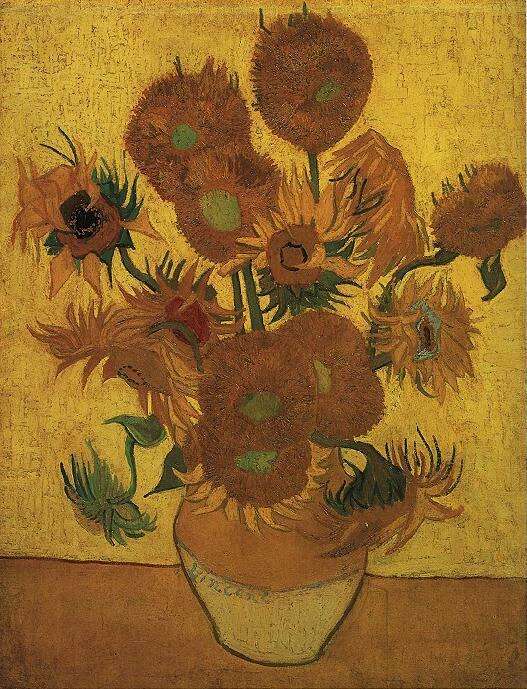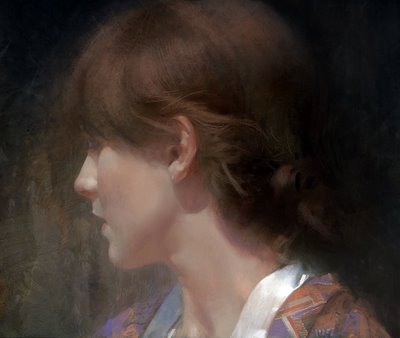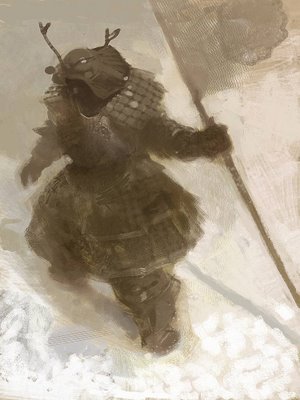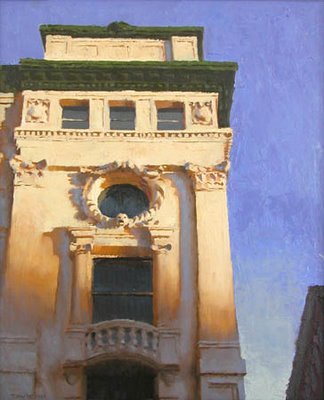
But wait a minute... it turns out that Van Gogh painted three other paintings just like it.

Or maybe it was four? Nobody knows for sure.

Someone argued that the $39.9 million painting must be a forgery, and suddenly it didn't look quite so beautiful.
Art experts hastily assembled to explain which of the five paintings had the "look" of a genuine Van Gogh. Unfortunately, the paintings had changed colors over time. The chrome yellow oil paint had darkened from exposure to atmosphere and the green paint changed color because of the copper acetoarsenite in the pigment.
So whatever the buyers were acquiring, it was not the artist's original vision.
Scientists, scholars, technicians, reporters and historians evaluated the painting. Some prepared long lists of issues:
The first of these concerns the leaf that belongs with the drooping flower to the left, number 14, through which the flower-stem passes. Leaves encompassing the stem in this way are not characteristic of sunflowers. In the first version-- the work in London-- the stem runs slightly into the leaf, which may have created the impression of a leaf encompassing a stem. The second concerns the broken stem of flower number 4. When sunflowers snap, the top part falls forward...but surprisingly this is not the case here.
Others claimed that the value of the art could be determined by a chemical analysis of the paint:
The composition of the priming layer allows us to date the work.... If this layer does indeed prove to consist of both barium sulfate and lead and/or zinc white, it would be reasonable to assume that the still life was painted in late November, when [Van Gogh] replaced the first type of primer with the second.
These are fitting topics for insurance companies and investment managers but not for people who care about art. For artists, it is the image that matters.
This all takes us back to digital art, which has an image but no physical existence. In recent exchanges, some of you have correctly pointed out that electromagnetic pictures create problems regarding scarcity, originality, authenticity, and even the fundamental nature of talent. But as the Van Gogh story demonstrates, so do physical objects. Sometimes the object becomes an albatross around the neck of art. Computer art may be dismaying to those who want to build a fence around an object and sell tickets, but for those who want to create digital images and cast them into the ether, computers give artists astonishing new tools.
There are days when I am utterly charmed by the idea of art without the constraints of earthbound objects. Those days are usually Saturday and Sunday, when I'm not trying to earn a living. But there are also days when the physical object is quite dear to me. We are fortunate to be living in a time of great transition. (I have a friend who claims that the invention of computers linked by the internet is slightly less important for human destiny than the invention of fire, but slightly more important than the invention of agriculture). These things will take time to work out.
For me, the one sure guide as we go forward is the quality of the image. I enjoy the work of dozens of computer artists, and in the past couple of weeks, you have alerted me to many more. I hope that readers have, with me, been exploring the links that have been suggested.
I agree with many of you that Craig Mullins is an extremely strong digital (as well as conventional) artist. The man knows how to draw and paint, and he enlists the computer to serve that talent as well as anyone I've ever seen.


Mullins has a good sense of color and drama and a real flair for design and I shall be visiting his website regularly.
One of my favorite young digital artists is Daisuke “dice” Tsutsumi , a visual development artist for animated films such as Robots. Like Mullins, Tsutsumi also works in traditional media:

Here he offers an excellent digital painting workshop showing how to use photoshop to paint an apple that looks as juicy as a Dean Cornwell oil painting. He is still growing, but I especially like Tsutsumi's attitude toward art. He chirps happily about drawing and painting while traveling, while standing in the rain, while eating lunch at his job or visting his family. He reminds me of a line from Jake Berthot:
An artist is rich if he has time. 'Making it' means having the time to make your work.Tsutsumi does "quick fun photoshop sketches" as seamlessly as he draws on a restaurant placemat. He is of the generation that will really begin to integrate and humanize computer art.

17 comments:
Digital art as well as traditional art both have their virtues and vices. The accessability of the internet has thrown away one of traditional arts vices by making, once museum only pieces, available to everyone. However, for myself, this has not made seeing the media in it's original form any less "magical".
Though digital art can not be held and touched as an object it does not take away from the talent required to make it, as you've pointed out.
But,there's something about the... "pureness" of traditional art that is more appealing to me. The artist does not have an "undo" button to correct a small mistake and has to work his/her way around it. The end result of a portrait done in a digital form vs traditional form may not vary considerably but I find the craftsmanship of the latter more aesthetically pleaseing.
Not to take away from the hours poured into digital pieces, it's just I find the bumps and bruises of an original painting are easier to see, adding to its "marvel".
This is my first post, and im continually enjoying the blogs you have been posting over the months. Great subjects.
Thanks, dmickey, and welcome. I understand what you mean about the "pureness of traditional art," although I suspect once computer art has been around long enough for people to humanize it with traditions, computer art will become "traditional art" as well. Think of how locomotives evolved. When they began, they were noisy, alien machines that frightened horses and scarred the landscape. A hundred years later, people were writing affectionate, nostalgic folk songs about them.
Concept art really seems to be one of the few stable or growing fields for illustrators. Comics and storyboarding as well. I think because of this we're seeing, for better or worse, a heavy emphasis on sci-fi and fantasy subject matter.
Realism or naturalistic "every day" scenes seem to be better represented in the daily art blogs.
David, it seems to me you are using the Van Gogh example as justifying the rule by means of the exception.
There's no doubt that a computer, being a different kind of tool, can be used by a skilled artist to do good work.
There is also no doubt that a skilled artist using traditional media can do good work.
The vast amount of commercial work is about the image, and since the image will be reproduced and the original usually means little, how the image is arrived at means little.
But without question, a far greater amount of money (far, far more) is invested in original rather than image-reproduced-ad-infinitum commerical work. And that market means a lot to the livlihood of many painters, and to a lot of collectors who collect both living and deceased artists' work. You are one of them. This exclusivity and originality means something, and the Van Gogh example proves it, rather than disproves it. Digital artwork will never be able to partake of this market, because there is no real original. That cuts off many talented people from being able to tap into this source for income, and that's important.
If you stay with traditional media, you can tap into this market, and the repro market with photographic reproduction of the work. With digital, only the reproduction market is available. Why would you use digital if you weren't just playing around or if you didn't have to?
To all of us who love beautiful images, it doesn't matter if we see an original or a nice photographic reproduction. And most of us pay very little for the priveledge too. But unfortunately, artists are material creatures who have material needs, and a great way to do this is to tap into the HUGE market for the sale and resale of original artwork. Almost none of the great images you like were done by part-time artists. Of course, there are exceptions. But again, I don't like to mistake the exception for the rule.
That is my only point. Scarcity of desired things makes them valuable. And if that's a way for talented people to make their way in this world, it seems to me that its a good path to pursue. Remember, traditonal media can partake of both the original and reproduction markets, while the digital can only partake of one. To me, that seems like a step in the wrong direction. And unless you are forced to make it, I don't understand why you would.
I actually agree with the thrust of brian's comment above. If you are talented and want to make a living as an artist, traditional media should play a part, not only for the valid monetary concerns, but also for the experience and the greater flexibility you gain from practicing with traditional media.
On the other hand, very time-constrained, for part-time amateurs like myself, digital art is an invaluable tool. It allows me to create images quickly enough, and experiment freely without worrying so much about the precious time and materials I'll end up wasting with my clumsy erasing and redrawing, or scraping off paint and cleaning brushes.
I would make a plea that digital art needs to be recognized as another medium, and Craig Mullins' work shows this attitude, I think. The way he works with pixels seems unlike paint in many ways, and the results are, it seems to me, meant for the screen, not canvas or paper.
I agree the lack of physicality in digital art is sometimes regrettable, but in other ways it seems to me like complaining that watercolor paintings are too flat to be sculpture, or that you can't touch a great film (well, you can, but it doesn't seem so important). It's a different art.
Well, that's my opinion, anyway.
Agree with Brian in every point he cites.
And would like to add that an original isn't just an image. It is the result of a visual research impressed on canvas with paint. It is like diary where every page (brush stroke) has something to tell about the artist and his environment in that very moment. You see the influence of time and the trueness of its existence in a finished original.
Of course the digital work can show this in some extension but, in most of the cases, simulated.
This discussion looks like that one on the introduction of the photographic camera.
Photography isn't an independent art form until the photo-secession movement, that started using photography as a new language with lots of influence from painted work. (In fact they imitate even the brushwork using gum bichromate.)
Maybe the digital art is touching a new approach totally different and independent.
Brian, Colin and anonymous, you will have to help me on this. The richest artists I know about have made their money not from selling originals, but from selling computer generated copies. Thomas Kinkade became fabulously wealthy selling prints with all kinds of fancy names-- "atelier" versions, "brushwork" (3 dimensional) versions, "miniature" versions, etc. He taps the market of people who can't afford an original (also the gullible and tasteless, but that's another issue). Frazetta is another example-- he doesn't have to sell his originals, he is rich from selling posters and other reproductions. Lots of other illustrators sell limited edition prints-- C.F. Payne, Tom Lovell, etc.
There are hundreds of other artists working where the public never sees an original, but "giclee" images are sold everywhere, just as people mass produced pseudo "lithographs" of work by Miro and Dali to scoop in bushel baskets of money. Combine this with fees and royalties that accompany published art, and I would guess that living artists make more from computer generated reproductions than from originals.
I don't have much recent experience trying to survive in the art market, but I concluded from this that computers have caused an infusion of cash into the market. You, on the other hand, seem certain that economic survival is tied to the original. Can you help flesh out the picture for me?
David,
My last post on this topic. I know 4 or 5 artists who sell their work and make a living from it. These are fine artists. I know of many more who do this as well, but I've met only a few. They paint traditionally, and do a very good job. They paint landscapes, portraits, still lifes, and some genre work. They don't make the kind of work that's going to have a huge reproduction market like Frazetta. But they sell enough each year (50-200k) to make a very nice living, or at least a middle class one.
Frank sells some of his originals, but very few. But by golly, the originals he has, if they were to hit the market, would be worth big money. If he did them all on the computer, where would that leave the family museum, or inheritance? He may not be popular forever. You could say the same thing about Rockwell.
The modern art market (which I despise) has made lots of money for its acolytes through the sale of original work. Not likely to be selling a lot of Francis Bacon paintings in malls across america.
The point I'm trying to make about digital art is that it isn't necesary to use it to reach the repro or original art markets. That's all. And if you aren't interested in animation, you can do the same stuff with traditional media that you can do with digital. Its only a two dimensional image. I don't see how digital advances 2-D art at all. I use computers to do technical drawing at my job too, and I love it--its much better than drafting by hand. But in the end, its no better than a "drawn" drawing.
I think digital can be great tool, but if there IS a market for selling original artwork, then I think it makes sense to do the final piece in traditional media. You can always scan it or photgraph it for reproduction. But try selling a CD as an original artwork. Hell, they degrade after about 10 years or so. And if you think there are attribution problems with real life paintings, wait until disputes arise over "authentic" digital art!
Hello David,
I didn't say that you can't make money out of digital art. I think that we live in a world where everybody is connected and the information is flowing in a way never seen before. Digital art is a answer to this needs (or is a product of these new possibilities). You can make big money selling copies of your work and this attitude reinforce the value of the image and not of the object (a Van Gogh is a object not just a image). Not that this is wrong or worse than sell a original!
Object and image are different things that will please different people and needs. An art collector will prefer an original while the casual admirer will not see the difference between the printed copy and the original. Not that one is better than the other, just different needs.
Illustration was always about printed copies serving one purpose. And the new possibilities of printing and technology are bringing this field to a new level of profit.
many of these splendid artist are my "heroes", i tried to make my best job to do a "natural" paint (only i tried, hehe), but in this case this artist give the real feeling of the great artist like davinci and other ones
Well, yes, if you want to make money as an artist computers have opened things up. I suppose I should have said I agree with some of brian's conclusions, but for slightly different reasons. Thinking about it, it seems the market for originals is more important to the somewhat successful professional "artist." Illustrators make their money from reproductions, as do highly successful artists (although their originals can sell for outrageous sums as well).
I wasn't thinking too much about the money, but more about how having experience with a variety of media is good for the artist.
(This suggests my answer to brian's question, too, of why an artist would go digital if that meant loosing the originals market: For the experience, and because digital can have it's own unique appeal.)
By the way, I completely messed up a sentence in my previous comment: "On the other hand, very time-constrained, for part-time amateurs like myself, digital art is an invaluable tool," should read "On the other hand, for very time-constrained, part time amateurs..." I should probably add "and very time-constrained, full-time professionals" as well. ;-)
There is so much here to react to, and we will never resolve everything. I enjoy reading these different perspectives-- they help me to supplement my own limited experience. But here are a few random reactions:
Brian and others who mentioned animation, I agree that is a totally different animal. It will become even more different from traditional art as 3D animation and holograms start to appear in the near future. We have not even begun to deal with that issue!
I think we have to be careful about drawing conclusions about art from the market forces we've witnessed in our short lifetimes. For most of history, there were no wealthy superstar artists. The technology of mass production and communication is what changed all that (not just for visual artists but composers and writers too.)
600 years ago if you wanted to illustrate books, you lived as a monk and illuminated manuscripts. You had to rule and letter everything by hand, rather than select a font and size and just type it in. If you screwed up, you spent a week doing the page over.
There was no such thing as copyright law until Guttenberg invented the printing press, because it was impossible to copy an illuminated manuscript (unless you happened to be another, equally talented, monk who could could copy it by hand.)
It was technology that enabled artists to leverage their talents and increase their efficiency (for example, enabling Rembrandt to sell multiple images of a single work, in the form of etchings). But we are unhappy with technology now because, 500 years after Guttenberg, technology threatens to undo all the good that technology previously did for the artist. Technology has made copyright laws virtually unenforceable, and it has blurred the line betweeb the skillful and those who can afford to buy software.
For those of you who still firmly believe in original objects, some experts argue that all creators (including artists and musicians) should not get royalies from protecting the intellectual; property of their work, but instead be paid only on a per-performance basis. They argue that whether we like this result or not, it is the only standard that ir practical to enforce in an era where digital copies are so freely made. They may be right.
Brian wrote:
That is my only point. Scarcity of desired things makes them valuable. And if that's a way for talented people to make their way in this world, it seems to me that its a good path to pursue. Remember, traditonal media can partake of both the original and reproduction markets, while the digital can only partake of one. To me, that seems like a step in the wrong direction. And unless you are forced to make it, I don't understand why you would.
As David alludes to, I don't think that we've lived in an original-dominated market for quite some time, thanks to printmaking. Among prints, there has been a market price attached to having the artist's initials in the bottom corner, even though a person could take an original and create a photocopy of it, or print one off the Internet and frame it. Collectors still value those initials, and artists have reaped the financial benefits thereof. For those whom the image is more than a wall decoration, it is critical to connect to the artist in some way.
That may be a limited number, of course. In a run-down neighborhood of my city, I recently saw a man camped out on a street corner, selling huge framed Bouguereau prints-on-canvas out of the back of his pickup truck. I doubt that his customers were thinking "I must connect with Bouguereau!" Or they may have thought that they were getting originals.
Was a beautiful page. Thanks to the designers and managers.
What I want to know is why you didnt think to include the other side of this issue? There are so many things that youre missing here that I dont see how you could actually form an intelligent opinion on the subject. Its like you didnt even consider that there me be another side here. Im kind of disappointed.
p90x-- I hope by now that you have discovered that I agree with you, and that the previous post was dedicated to the other side of the issue.
many of these splendid artist are my "heroes", i tried to make my best job to do a "natural" paint (only i tried, hehe), but in this case this artist give the real feeling of the great artist like davinci and other ones
Post a Comment